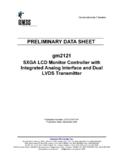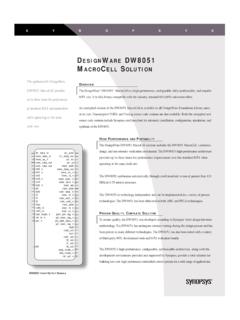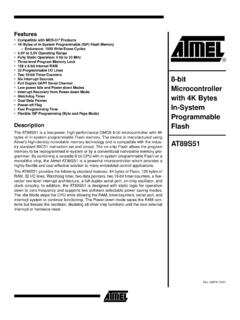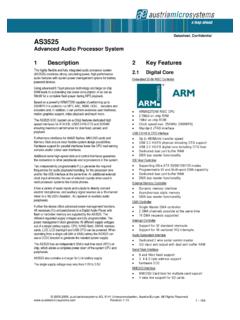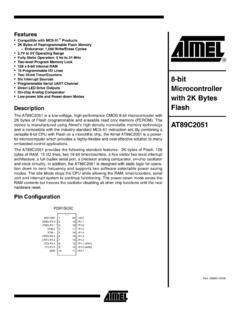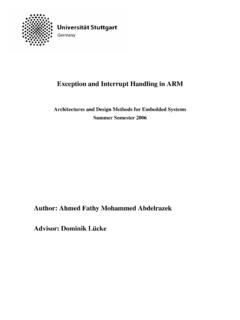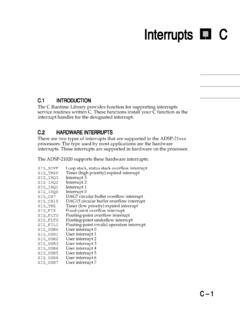Transcription of Cortex-M0+ Devices Generic User Guide
1 Copyright 2012 ARM. All rights DUI 0662A (ID041812)Cortex-M0+ DevicesGeneric User Guide ARM DUI 0662 ACopyright 2012 ARM. All rights + DevicesGeneric User GuideCopyright 2012 ARM. All rights InformationThe following changes have been made to this NoticeWords and logos marked with or are registered trademarks or trademarks of ARM in the EU and other countries, except as otherwise stated below in this proprietary notice. Other brands and names mentioned herein may be the trademarks of their respective the whole nor any part of the information contained in, or the product described in, this document may be adapted or reproduced in any material form except with the prior written permission of the copyright product described in this document is subject to continuous developments and improvements. All particulars of the product and its use contained in this document are given by ARM in good faith.
2 However, all warranties implied or expressed, including but not limited to implied warranties of merchantability, or fitness for purpose, are document is intended only to assist the reader in the use of the product. ARM shall not be liable for any loss or damage arising from the use of any information in this document, or any error or omission in such information, or any incorrect use of the the term ARM is used it means ARM or any of its subsidiaries as appropriate .Confidentiality StatusThis document is Non-Confidential. The right to use, copy and disclose this document may be subject to license restrictions in accordance with the terms of the agreement entered into by ARM and the party that ARM delivered this document StatusThe information in this document is final, that is for a developed historyDateIssueConfidentialityChange04 April 2012 ANon-ConfidentialFirst release ARM DUI 0662 ACopyright 2012 ARM.
3 All rights + Devices Generic User GuidePrefaceAbout this book .. viFeedback .. viiiChapter the Cortex-M0+ processor and core peripherals .. 1-2 Chapter 2 The Cortex-M0+ model .. model .. model .. handling .. management .. 2-23 Chapter 3 The Cortex-M0+ Instruction set summary .. functions .. the instruction descriptions .. access instructions .. data processing instructions .. and control instructions .. instructions .. 3-36 Chapter 4 Cortex-M0+ the Cortex-M0+ peripherals .. Vectored Interrupt Controller .. Control Block .. timer, SysTick .. 4-16 ContentsARM DUI 0662 ACopyright 2012 ARM. All rights Protection Unit .. I/O Port .. 4-28 ARM DUI 0662 ACopyright 2012 ARM. All rights preface introduces the Cortex-M0+ Devices Generic User Guide . It contains the following sections: About this book on page vi Feedback on page viiiPreface ARM DUI 0662 ACopyright 2012 ARM.
4 All rights this bookThis book is a Generic user Guide for Devices that implement the ARM Cortex-M0+ processor. Implementers of Cortex-M0+ processor designs make a number of implementation choices, that can affect the functionality of the device. This means that, in this book: some information is described as implementation-defined some features are described as the documentation from the supplier of your Cortex-M0+ device for more information about these this book, unless the context indicates otherwise:Processor Refers to the Cortex-M0+ processor, as supplied by Refers to an implemented device, supplied by an ARM partner, that incorporates a Cortex-M0+ processor. In particular, your device refers to the particular implementation of the Cortex-M0+ processor that you are using. Some features of your device depend on the implementation choices made by the ARM partner that made the revision statusThe rnpn identifier indicates the revision status of the product described in this book, where:rn Identifies the major revision of the Identifies the minor revision or modification status of the audienceThis book is written for application and system-level software developers, familiar with programming, who want to program a device that includes the Cortex-M0+ this bookThis book is organized into the following chapters.
5 Chapter 1 Introduction Read this for an introduction to the Cortex-M0+ processor and its 2 The Cortex-M0+ Processor Read this for a description of the programmers model, the processor memory model, exception and fault handling , and power 3 The Cortex-M0+ Instruction Set Read this for a description of the processor instruction 4 Cortex-M0+ Peripherals Read this for a description of the Cortex-M0+ core ARM Glossary is a list of terms used in ARM documentation, together with definitions for those terms. The ARM Glossary does not contain terms that are industry standard unless the ARM meaning differs from the generally accepted ARM Glossary, ARM DUI 0662 ACopyright 2012 ARM. All rights ConventionsThe typographical conventions are:italic Introduces special terminology, denotes cross-references, and Highlights interface elements, such as menu names.
6 Denotes signal names. Also used for terms in descriptive lists, where Denotes text that you can enter at the keyboard, such as commands, file and program names, and source Denotes a permitted abbreviation for a command or option. You can enter the underlined text instead of the full command or option italic Denotes arguments to monospace text where the argument is to be replaced by a specific bold Denotes language keywords when used outside example code. < and > Enclose replaceable terms for assembler syntax where they appear in code or code fragments. For example:MRC p15, 0 <Rd>, <CRn>, <CRm>, <Opcode_2>Additional readingThis section lists publications by ARM and by third Infocenter, , for access to ARM publicationsThis book contains information that is specific to this product. See the following documents for other relevant information: Cortex-M0+ Technical Reference Manual (ARM DDI 0484) ARMv6-M Architecture Reference Manual (ARM DDI 0419).
7 Other publicationsThis Guide only provides Generic information for Devices that implement the ARM Cortex-M0+ processor. For information about your device see the documentation published by the device ARM DUI 0662 ACopyright 2012 ARM. All rights welcomes feedback on this product and its on this productIf you have any comments or suggestions about this product, contact your supplier and give: The product name. The product revision or version. An explanation with as much information as you can provide. Include symptoms and diagnostic procedures if on contentIf you have comments on content then send an e-mail to Give: the title the number, ARM DUI 0662A the page numbers to which your comments apply a concise explanation of your also welcomes general suggestions for additions and ARM tests the PDF only in Adobe Acrobat and Acrobat Reader, and cannot guarantee the quality of the represented document when used with any other PDF DUI 0662 ACopyright 2012 ARM.
8 All rights 1 IntroductionThis chapter introduces the Cortex-M0+ processor and its features. It contains the following section: About the Cortex-M0+ processor and core peripherals on page ARM DUI 0662 ACopyright 2012 ARM. All rights the Cortex-M0+ processor and core peripheralsThe Cortex-M0+ processor is an entry-level 32-bit ARM Cortex processor designed for a broad range of embedded applications. It offers significant benefits to developers, including: a simple architecture that is easy to learn and program ultra-low power, energy-efficient operation excellent code density deterministic, high-performance interrupt handling upward compatibility with Cortex-M processor family platform security robustness, with optional integrated Memory Protection Unit (MPU).Figure 1-1 Cortex-M0+ implementationThe Cortex-M0+ processor is built on a highly area and power optimized 32-bit processor core, with a 2-stage pipeline von Neumann architecture.
9 The processor delivers exceptional energy efficiency through a small but powerful instruction set and extensively optimized design, providing high-end processing hardware including either: a single-cycle multiplier, in designs optimized for high performance a 32-cycle multiplier, in designs optimized for low Cortex-M0+ processor implements the ARMv6-M architecture, that is based on the 16-bit Thumb instruction set and includes Thumb-2 technology. This provides the exceptional performance expected of a modern 32-bit architecture, with a higher code density than 8-bit and 16-bit Cortex-M0+ processor closely integrates a configurable Nested Vectored Interrupt Controller (NVIC), to deliver industry-leading interrupt performance. The NVIC: includes a Non-Maskable Interrupt (NMI) provides zero jitter interrupt option provides four interrupt priority (NVIC) Cortex-M0+ processorcoreBreakpoint &WatchpointUnitsDebuggerinterfaceOptiona l MemoryProtectionUnit (MPU)Bus matrixOptional WakeupInterruptController(WIC)Optional Micro Trace Buffer(MTB)Optional DebugAccess PortCortex-M0+ ProcessorOptional DebugCortex-M0+ ComponentsInterruptsAHB-Lite interfaceto systemOptionalsingle-cycleI/O portOptionalSerial-Wire or JTAG debug portIntroduction ARM DUI 0662 ACopyright 2012 ARM.
10 All rights tight integration of the processor core and NVIC provides fast execution of Interrupt Service Routines (ISRs), dramatically reducing the interrupt latency. This is achieved through the hardware stacking of registers, and the ability to abandon and restart load-multiple and store-multiple operations. Interrupt handlers do not require any assembler wrapper code, removing any code overhead from the ISRs. Tail-chaining optimization also significantly reduces the overhead when switching from one ISR to optimize low-power designs, the NVIC integrates with the sleep modes. Optionally, sleep mode support can include a deep sleep function that enables the entire device to be rapidly powered interfaceThe Cortex-M0+ processor provides a single system-level interface using AMBA technology to provide high speed, low latency memory Cortex-M0+ processor has an optional Memory Protection Unit (MPU) that provides fine grain memory control, enabling applications to use privilege levels, separating and protecting code, data and stack on a task-by-task basis.




